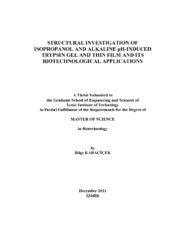Please use this identifier to cite or link to this item:
https://hdl.handle.net/11147/3159Full metadata record
| DC Field | Value | Language |
|---|---|---|
| dc.contributor.advisor | Ceylan, Çağatay | en |
| dc.contributor.author | Karaçiçek, Bilge | - |
| dc.date.accessioned | 2014-07-22T13:51:00Z | - |
| dc.date.available | 2014-07-22T13:51:00Z | - |
| dc.date.issued | 2011 | en |
| dc.identifier.uri | http://hdl.handle.net/11147/3159 | - |
| dc.description | Thesis (Master)--Izmir Institute of Technology, Biotechnology, Izmir, 2011 | en |
| dc.description | Includes bibliographical references (leaves: 68-81) | en |
| dc.description | Text in English; Abstract: Turkish and English | en |
| dc.description | xiii, 84 leaves | en |
| dc.description.abstract | Trypsin is a biologically and industrially important member of serine protease family. Gelation forms a three dimensional network structure through the interaction of protein molecules among themselves and also with the environment. The aim of the study was the investigation of structural and the functional properties of bovine pancreatic trypsin after gelation and aggregation processes. The phase behaviour of trypsin was determined for different protein concentration, NaOH concentration and CaCl2 concentrations. In addition, the effect of sucrose addition to gelation time was observed. Increasing protein concentrations caused a decrease in gelation time. Increasing NaOH concentrations resulted in a decrease in gelation time. In low CaCl2 concentrations gelation was observed but in high CaCl2 concentrations aggregation was observed. The gels were resolubilized in water. Trypsin stability studies showed that there was a nearly 50% specific activity loss after the gelation process. According to FTIR studies β–sheet structure in 1637 cm-1 band disappeared in trypsin gel and trypsin aggregates. Increases in α–helix structure in 1651 cm-1 in trypsin gel with sucrose and aggregate with and without sucrose were observed. Iodoacetamide was shown to delay in gelation indicating the importance of intermolecular disulfides in the gelation process. The QCM studies showed that the film formed after gelation had absorbtion ability to different gases (benzene, carbon monoxide, carbon dioxide, dichloromethane, hydrogen peroxide and propanol) and can be used for gas sensing purposes. GI-XRD studies showed that trypsin thin film did not contain any crystalline structures. | en |
| dc.language.iso | en | en_US |
| dc.publisher | Izmir Institute of Technology | en |
| dc.rights | info:eu-repo/semantics/openAccess | en_US |
| dc.subject.lcsh | Trypsin | en |
| dc.subject.lcsh | Gelation | en |
| dc.subject.lcsh | Fourier transform spectroscopy | en |
| dc.subject.lcsh | Quartz crystal microbalances | en |
| dc.subject.lcsh | X-rays--Diffraction | en |
| dc.title | Structural investigation of isopropanol and alkaline pH-induced trypsin gel and thin flim and its biotechnological applications | en_US |
| dc.type | Master Thesis | en_US |
| dc.institutionauthor | Karaçiçek, Bilge | - |
| dc.department | Thesis (Master)--İzmir Institute of Technology, Bioengineering | en_US |
| dc.relation.publicationcategory | Tez | en_US |
| item.languageiso639-1 | en | - |
| item.fulltext | With Fulltext | - |
| item.openairecristype | http://purl.org/coar/resource_type/c_18cf | - |
| item.openairetype | Master Thesis | - |
| item.grantfulltext | open | - |
| item.cerifentitytype | Publications | - |
| Appears in Collections: | Master Degree / Yüksek Lisans Tezleri Sürdürülebilir Yeşil Kampüs Koleksiyonu / Sustainable Green Campus Collection | |
Files in This Item:
| File | Description | Size | Format | |
|---|---|---|---|---|
| T000972.pdf | MasterThesis | 2.15 MB | Adobe PDF |  View/Open |
CORE Recommender
Page view(s)
102
checked on Jul 22, 2024
Download(s)
70
checked on Jul 22, 2024
Google ScholarTM
Check
Items in GCRIS Repository are protected by copyright, with all rights reserved, unless otherwise indicated.